Beijing Impressions: Day 1+
After about 24 hours in Beijing, there is so much to tell. We have mostly gotten over the 13 hour flight and have had a full day of food, visits to an international school, and city. Here is a set of impressions for now, along with some questions for YOU:
Airport
The international hall where we waited in many lines to be admitted to the country was eerily quiet. Even with hundreds of people lined up for multiple desks for “citizens” and “foreigners” (in Chinese and English signage), there was very little sound. I did not take a photo because it felt as though I perhaps was not supposed to. But each of us in our group of 35 Americans noticed the hush, a muted sensation uncharacteristic of Americans anywhere. The airport itself is beautiful, clean, and very efficient. Our guide pointed out that the expressway we took into the city was built for the 2008 Olympics, as much of the airport appeared to be, also. Does your city have any buildings or special features that were build because of a recent event– or one even a century ago?
Color
Visually, the first impression of Beijing is taupe: that odd, muddy color between gray and brown not unlike very old coffee from the bottom of the pot when you add a lot of milk to it — or possibly like smoky eyeshadow. Even the soil has an odd taupe color. My color impression is not a metaphor for the life within Beijing, however. If you had to pick a”color” as the first impression of your town/city, what would it be?
Traffic
The traffic is insane. Pedestrians take their lives into their hands. Cars, motor-scooters, taxis, and buses all have the right of way and do not slow at all for pedestrians in crosswalks. We learned quickly to follow a Chinese person to dodge our way through 8 lanes of traffic. Even at 2 a.m. (when I was awake from the time zone change!), the horns blow outside our hotel. We are glad we have a shuttle bus to almost everywhere we will go. How often have you helped a stranger find his/her way on your town? Would people where you live offer to help?
People
Everyone has been very friendly, though we have not met any “ordinary people” yet. The high end shopping mall across the street, with stores like Gucci and Porsche, is not a likely place to see the “everyday people”! Stay tuned on this.
Fashion(!)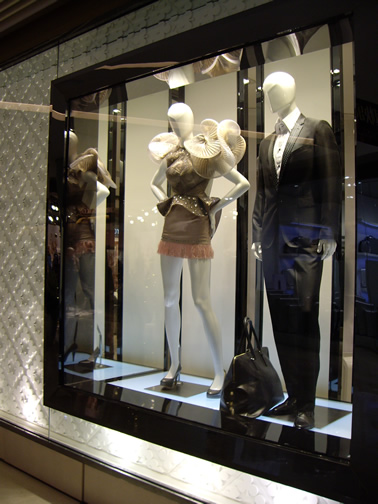
I had to include one picture we took in the high-end mall. I don’t think I will be buying this dress for the holidays. People on the street look the same as those in the U.S. in colder weather: winter coats, etc. The weather has not been that cold, but is supposed to be colder tomorrow. Do you have store windows near you that display outfits few would actually wear?
Cars
I have seen many Volkswagens, Audis, BMWs, and VW Jetta cabs. We walked past a BMW dealer down the street with a nice shiny convertible in the window and young couples inside talking to a salesman. Is your town a Ford pickup town, subway and taxi city, or a SUV suburb?
Language
Ni hao is hello in Chinese. That is all I can say. Everyone who sees you (inside) says it, but not strangers on the sidewalks. Many signs have English in this city because there are so many tourists, but the stores and restaurants that serve the Chinese residents have only Chinese signs in very bright colors. Do you ever meet people who know very few word of your language? What do you say to them?
Christmas!
We have been surprised to see as many Christmas decorations as we have and to hear Christmas music in the lobby and shopping areas, since most Chinese do not celebrate Christmas. We think this is because it makes tourists feel more at home and more willing to spend money (?) What do shops and restaurants where you live do to make people willing to spend?
Food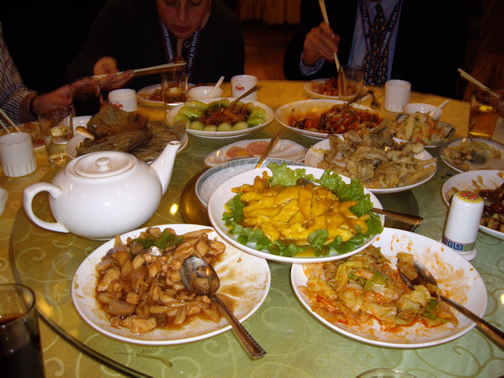
Setting aside the challenges of using chopsticks, the food is amazing. Our hotel definitely caters to “westerners,” so the restaurant has both Chinese and other types of food. The presentation is beautiful, sometimes better than it actually tastes, but we can certainly tell that EVERYONE in China wants to make a positive impression on us as American visitors. We had a traditional style lunch in a Chinese restaurant, served at round tables with large, glass “lazy susans.” The many dishes just kept coming, and hey were wonderful. There is very little beef, though the Korean restaurant we went to for dinner had plenty of beef. 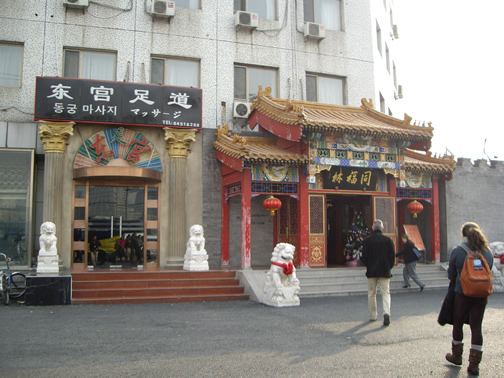 Although we had been told that “everyone speaks English,” that is not true of servers in the restaurants. They know few words, but they find someone who can help if we ask a question. Diet Coke costs about $3.50 or more and is far less common than the ubiquitous Coke, Sprite and bottled water. Even the Chinese do not drink the water unless they boil it for tea. I guess Pepsi has not made it to Beijing. What does your townor city do to make a positive impression on visitors? Do you get many visitors? If you had to feed them one or two dishes that are most typical where you live, what would they be? What would be the “special occasion” meal you would offer very special guests?
Although we had been told that “everyone speaks English,” that is not true of servers in the restaurants. They know few words, but they find someone who can help if we ask a question. Diet Coke costs about $3.50 or more and is far less common than the ubiquitous Coke, Sprite and bottled water. Even the Chinese do not drink the water unless they boil it for tea. I guess Pepsi has not made it to Beijing. What does your townor city do to make a positive impression on visitors? Do you get many visitors? If you had to feed them one or two dishes that are most typical where you live, what would they be? What would be the “special occasion” meal you would offer very special guests?
BISS Beijing International School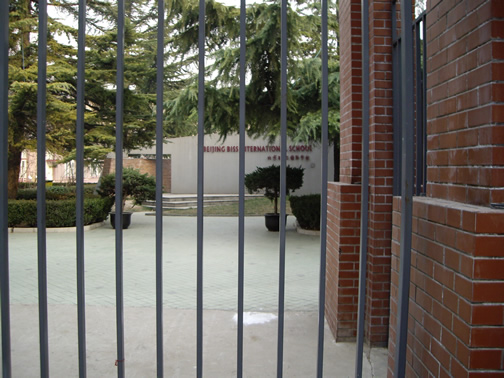
We visited the BISS Beijing International School, a small private school (Preschool- gr 12) with students from many countries. This is not a public school or one that would be typical for the average Chinese student. Families pay tuition to send their children there, and it is expensive. These children are in Beijing because their parents have important jobs, many working at the Beijing embassies for other countries such as Korea, Germany, India, and others. The school is conducted in English, though it is the second language for the majority of the students. The head of the school explained that these families stay in Beijing for 2-3 years, then the parents move to another assignment, making them “global nomads” or “third culture kids.” 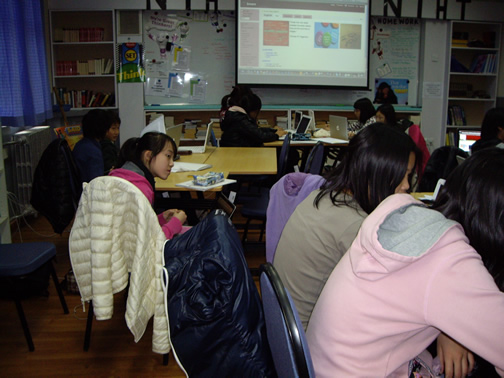 The school was very welcoming and uses technology extensively. Students have their own laptops beginning in grade 5 (purchased by their family). The lower grades use netbooks and both Mac and Windows computers. There is beautiful student artwork throughout the school.
The school was very welcoming and uses technology extensively. Students have their own laptops beginning in grade 5 (purchased by their family). The lower grades use netbooks and both Mac and Windows computers. There is beautiful student artwork throughout the school.
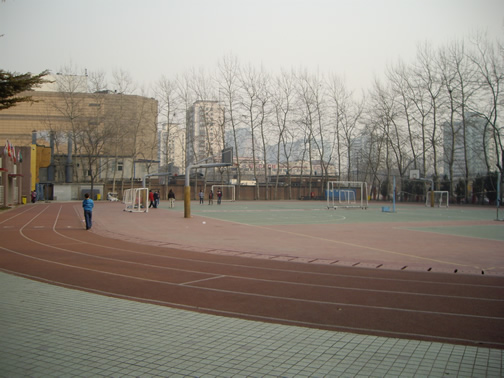 Their building has grades K-12 in one rather ordinary building (four floors), and they have a tiny paved outdoor athletic space and careful security (fence, barbed wire, guards). They get to use some of the Olympic venues for their sports, however, including the “Birds Nest” track and field stadium which is walking distance from the school! Because of the many nations represented in the school, there is a very strong appreciation for culture. How many nationalities and languages can you find in your school?
Their building has grades K-12 in one rather ordinary building (four floors), and they have a tiny paved outdoor athletic space and careful security (fence, barbed wire, guards). They get to use some of the Olympic venues for their sports, however, including the “Birds Nest” track and field stadium which is walking distance from the school! Because of the many nations represented in the school, there is a very strong appreciation for culture. How many nationalities and languages can you find in your school?
Interesting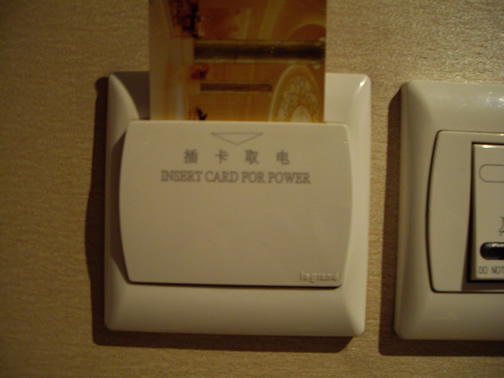
Our hotel room has a cool power saving feature. Our room key cards turn on the power for the lights. When you enter, you insert the card to make the light switches and lamps work. As you exit and remove the keycard, the lights stay on for about 30 seconds like the ones in a car. No one can waste energy. Can you think of any tricky features you could invent to save money on water or power at your home or school?
East/West
I still need to get a picture of this, but Chinese traditional (“Eastern”) bathrooms are very different from U.S. bathrooms. They do not have toilets/commodes/water closets. They are like a hole in the ground. Stay tuned for a photo!
I need to tell you more about the money and more…perhaps tomorrow. Tomorrow we visit a university where Chinese students study to become teachers and a high school there, as well. What do YOU want to know?

 and using it on wifi when I can. At least the calendar will still work, but none of the cool apps that connect to the web, unless I want to pay BIG bucks for data roaming.
and using it on wifi when I can. At least the calendar will still work, but none of the cool apps that connect to the web, unless I want to pay BIG bucks for data roaming.



